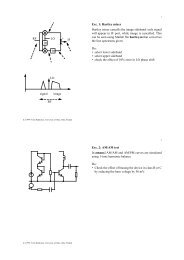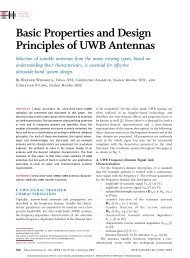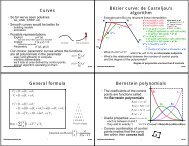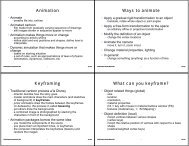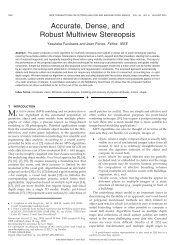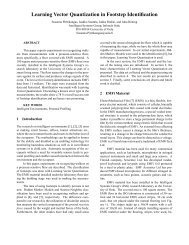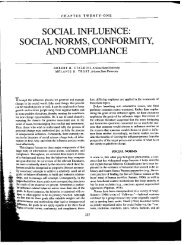On the Effect of Radio Channel Propagation Models - Oulu
On the Effect of Radio Channel Propagation Models - Oulu
On the Effect of Radio Channel Propagation Models - Oulu
Create successful ePaper yourself
Turn your PDF publications into a flip-book with our unique Google optimized e-Paper software.
able to track two separate channels simultaneously. In our<br />
spread spectrum approach, nodes are able to track transmissions<br />
with two different spreading codes. <strong>On</strong>e is a<br />
common code channel (C-code), which is used for route<br />
maintenance and broadcast communications. The o<strong>the</strong>r is a<br />
receiver based code channel (R-code), which is unique for<br />
each node, unlike <strong>the</strong> C-code. R-code is used for all directed<br />
transmission (e.g., data) per hop basis. [6]<br />
Since BCCA is a channel access method to enable distributed<br />
CDMA-like (Code Division Multiple Access) communications<br />
for ad hoc networks, a medium access control<br />
(MAC) method is also needed. BC-MAC is designed to be<br />
used with BCCA. It is a straightforward CSMA-based<br />
(Carrier Sense Multiple Access) MAC solution with fast<br />
ARQ (Automatic Repeat Request) implementation. BC-<br />
MAC with BCCA has been shown to have very high performance<br />
in ad hoc environment. [7]<br />
With <strong>the</strong> use <strong>of</strong> BCCA, it is required that <strong>the</strong> R-type<br />
spreading codes <strong>of</strong> <strong>the</strong> nodes are known, For <strong>the</strong> cases<br />
where <strong>the</strong> codes are unknown, an efficient network layer<br />
spreading code distribution method is being developed.<br />
However, we will use <strong>the</strong> assumption <strong>of</strong> known codes in<br />
this paper, since it is a fair assumption in military scenarios.<br />
Hereafter, when we refer to BC-MAC, it is assumed<br />
that BCCA functionality is also implemented to it.<br />
B. IEEE 802.11<br />
The basic IEEE 802.11 (later referred to as 802.11) is considered<br />
as a point <strong>of</strong> comparison. The modeling <strong>of</strong> 802.11<br />
is based on <strong>the</strong> basic OPNET model <strong>of</strong> 802.11 with some<br />
modifications to enable <strong>the</strong> functionality with <strong>the</strong> used<br />
routing protocol (as in our previous studies [6], [7]). Some<br />
modifications were also needed to enable <strong>the</strong> possibility to<br />
use different propagation models, but no functional<br />
changes to <strong>the</strong> MAC have been made.<br />
The DSSS (Direct Sequence Spread Spectrum) mode <strong>of</strong><br />
802.11 is used, since DS spreading is also used in BC-<br />
MAC. Virtual carrier sensing is not used, because it produces<br />
additional overhead [8], which is not desired (multiple<br />
handshaking transmissions, latency, capacity decrement<br />
under heavy traffic). Carrier sensing is done by<br />
power level measurement with a threshold in both 802.11<br />
and BC-MAC. This threshold is set according to <strong>the</strong> power<br />
level, where <strong>the</strong> reception is just more likely to succeed<br />
than fail in <strong>the</strong>ory.<br />
C. The Physical Layer<br />
At <strong>the</strong> physical layer, channel data rate is set to 1 Mbit/s.<br />
To allow potentiality for interference suppression and to<br />
enhance LPD (Low Probability <strong>of</strong> Detection) and LPI<br />
(Low Probability <strong>of</strong> Interception) properties, sufficient<br />
2 <strong>of</strong> 7<br />
spreading factor is needed. Spreading code length <strong>of</strong> Nc<br />
= 63 chip is used. With bit-wise spreading, processing<br />
gain is directly 63 (- 18.0 dB). To make fair comparisons<br />
between BC-MAC and 802.11, <strong>the</strong> same spreading<br />
factor is also set to 802.11 instead <strong>of</strong> <strong>the</strong> standard value<br />
<strong>of</strong> 11. The frame formats are set to be equal according to<br />
- 802.11. The systems operate on 2.4 GHz ISM (Industrial,<br />
Scientific and Medical) frequency band.<br />
B. The Network Layer<br />
The network layer functionality is kept simple enough so<br />
that it does not provide any extra effects to <strong>the</strong> results.<br />
The functionality is mainly under control <strong>of</strong> Ad hoc <strong>On</strong>demand<br />
Distance Vector (AODV) routing protocol with<br />
some basic characteristics <strong>of</strong> IP (Internet Protocol). But<br />
for example address resolution protocol (ARP) is not<br />
used, instead, it is assumed for simplicity, that <strong>the</strong> MAC<br />
and network layer share <strong>the</strong> same address base.<br />
AODV is a reactive pure on-demand type routing protocol,<br />
where routes are formed and updated only when<br />
needed [9]. The used OPNET model <strong>of</strong> AODV is <strong>the</strong><br />
same as in our previous work (e.g., [6], where it is also<br />
described how to enable BCCA functionality with<br />
AODV). AODV hello-messages and passive listening at<br />
MAC layer are not used, because in military scenario,<br />
we want to avoid extra control traffic<br />
C. Transport & Application Layer<br />
In order to keep <strong>the</strong> focus on lower layer functionalities,<br />
it is not desired that <strong>the</strong> upper layers will add complexity<br />
and more parameters to <strong>the</strong> currently already quite large<br />
set <strong>of</strong> parameters. Thus, transport layer functionalities<br />
are minimized and <strong>the</strong> layer above network layer is basically<br />
<strong>the</strong> application layer. In a sense, <strong>the</strong> transport layer<br />
can be assumed to exist as UDP-lite (Lightweight User<br />
Datagram Protocol, [10]), if one assumes that <strong>the</strong> UDP<br />
fields exist in <strong>the</strong> data packet.<br />
Application layer is modeled statistically with traffic<br />
models. VBR-M [6] model is used as a traffic model,<br />
and <strong>the</strong> data packet length has a constant value <strong>of</strong> 4096<br />
bits. Because <strong>the</strong> focus is on lower layer functionalities,<br />
heavy tailed modern data traffic models are not used,<br />
since <strong>the</strong>y also introduce <strong>the</strong>ir own effects to <strong>the</strong> network<br />
performance (e.g., [11]). As a session model, dynamic<br />
connections are used [7].<br />
E. Simulation Scenarios and performance metrics<br />
This study is based on OPNET simulations. A basic ad<br />
hoc scenario is chosen, where <strong>the</strong> operational area has a<br />
size <strong>of</strong> 1500 m x 300 m and <strong>the</strong> nodes have effective<br />
radio range <strong>of</strong> about 250 m. The area contains 50 nodes,<br />
<strong>of</strong> which 20 run applications (i.e., generate traffic), but







